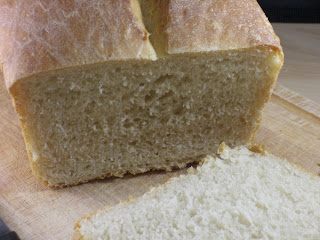
The dough must be quite sticky and soft to start with. It will firm up when kneaded and as time progresses.
- Once you have soft sticky dough leave it covered in the bowl for 10 minutes.
- Now oil your kneading surface and hands and tip the dough out.
- Knead for about 12 seconds by folding in the edges to the centre, a bit like shaping a round loaf, rotate the dough as you go.
- Flip the dough over, leave it on the surface and cover with a cloth. Wash out the bowl and then oil it lightly. Put the dough back in the bowl and cover.
- Leave for 10-15 minutes and then do another 12 second knead. You will notice the dough is already less sticky and firmer.
- Leave for 20 -30 mins and repeat the fast knead. You are aiming to have kneaded the dough 3 times in the first hour.
- Leave covered to rise until at least 50% larger but not more than double in size.
- Tip out onto the oil surface and press the air out of the dough using the tips of your fingers so its square-ish in shape. Repeat the fast knead process (or fold in to thirds then rotate through 90, flatten again and fold into 3rds again).
- Shape the dough as required for the particular loaf you are making. Put it in a tin, or supported in a floured cloth in a bowl.
- Leave to rise until at least 50% larger and preferably almost double in size.
- Slash top and bake as per your recipe.
Ingredients:
200g semi skimmed milk at room temp (Dan uses whole milk but semi skimmed seems to work fine)
150g water at room temp (remember 1g = 1ml but its easier to be accurate weighing fluids)
1 tsp fast action yeast (or 2 tsp fresh yeast crumbled)
200g plain white flour
300g strong white bread flour
1 ½ tsp fine sea salt
Method:
Mix the flours and salt together in a bowl.
Mix the water and milk together in a separate bowl and whisk in the yeast.
Add the liquid to the flour and mix with the fingers of one hand to a soft sticky rough dough. You may need to add a little more liquid do this a teaspoon at a time until you have a soft sticky dough.
Follow the kneading instructions above.
The first rise will probably take about an hour from the last knead.
To shape for a tin loaf, flatten the dough to a square about the same width as your tin. Roll the dough into a cylinder and press the seam firmly, fold under the two short ends and place in the tin seam side down.
Allow to rise (covered) to 1 ½ to 2 times volume i.e. to the top of the tin.
Slash the top of the loaf along it length and put it straight into the oven for 10 minutes at maximum temperature. After 10 minutes check how it’s browning and drop the temperature as follows (these baking guidelines are from the River Cottage Bread Book):
R6/200C if the crust is pale
R4/180C if crust is noticeably browning
R3/170C if crust is browning quickly
And cook for a further 40-50 minutes.
I usually check again part way through this time and either adjust temperature again or cover the top with foil if it’s brown enough. Also note that with a traditional gas oven (i.e. one without a fan) the top may brown far too quickly on the side near the heat at the initial temperature so you might want to start at a lower setting of R8/9 for the first 10 minutes. Adapt the setting for what you know about your oven and how things usually bake.
When it’s cooked turn it out of the tin and allow to cool.
Then when it’s cooled cut a big huge doorstop of a slice toast it and slather with lashing of butter. Yum.






3 comments:
Very nice loaf! I love the thin and semi-brown crust you got!
Regards, Maja
Glad you liked the kneading technique. I really enjoy the kneading by hand and watching/feeling the dough change as you work with it, its also rather soothing!
Its definitely a mild tasting loaf and I do usually do it as 50:50 white to wholemeal but every now and then I just have to have the white version.
I managed to burn the one I did for the challenge - ooops!
Lovely soft looking crumb. I agree with it making a milder tasting loaf.
Post a Comment